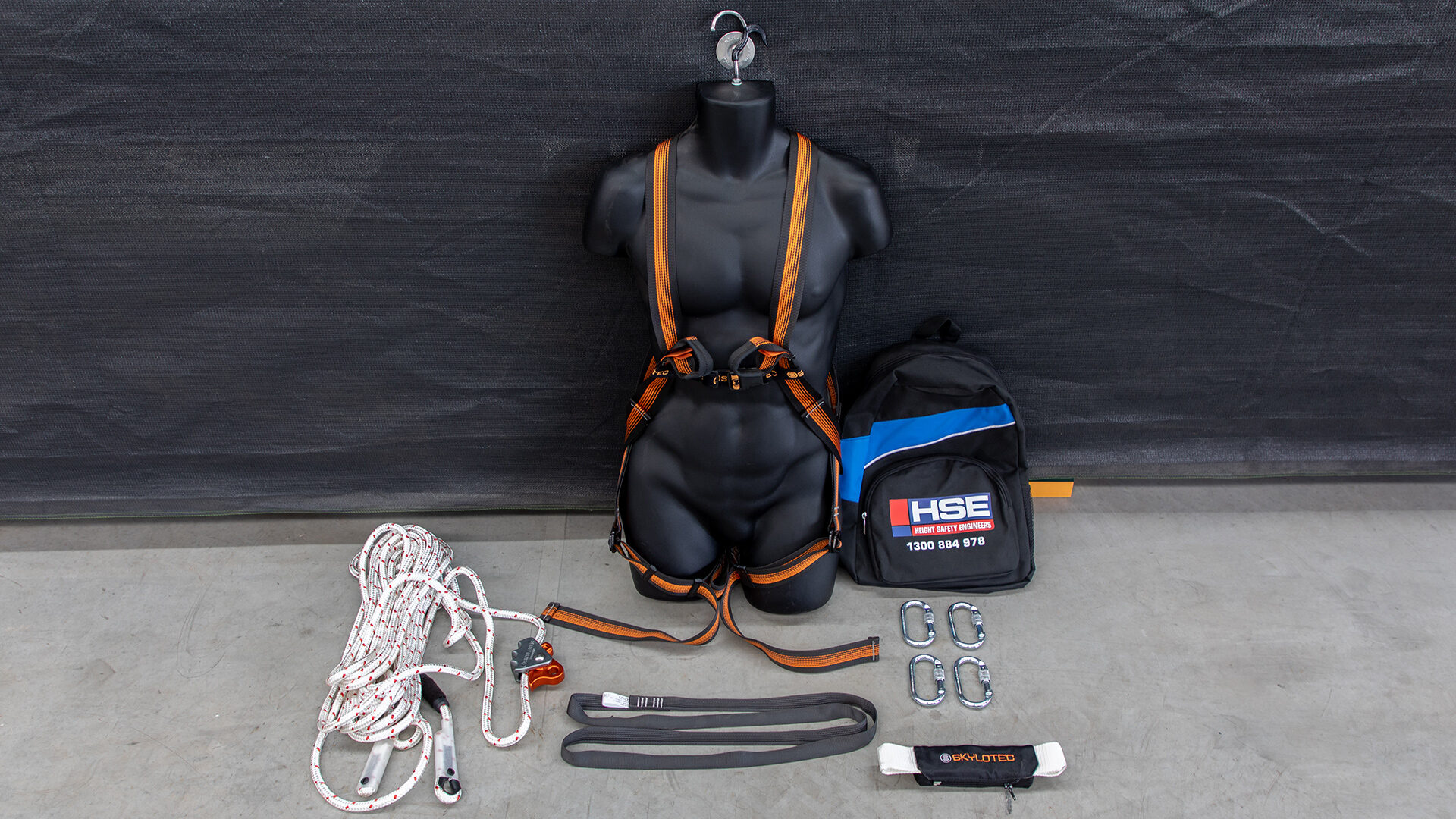Working on a roof – any roof – introduces the risk of a fall. A “Roofer’s Kit” is basic safety equipment that any tradesperson working at heights should have in their truck.
UPDATE 26 February 2021: You may have noticed on our website that the components used in our Roofer’s Kit differ from the ones shown here. The decision to pivot to a SafetyLink supplied kit came about as we could offer buyers the same level of protection while improving value. The 2021 HSE Roofer’s Kit still includes a harness, rope line, anchor strap, shock absorber and carry bag, but now includes a total of six (6!) carabiners. The new shock pack and rope line has two fixed carabiners, and we have retained the four loose carabiners of the original kit. This means users have even greater flexibility when using the HSE Roofer’s Kit.
A basic ‘roofer’s kit’ is industry-standard personal protection equipment (PPE) product that is available in a variety of different forms. It is the entry-level amount of equipment that a person should have when working at heights.
Generally, the base components of the kit include a harness, anchor strap, carabiners, a shock absorber and a simple bag to keep it all in. With less than half-a-dozen items, a user can engage with work being conducted at heights using a variety of different safety systems while remaining protected from falls and being compliant with relevant safe work legislation
At Height Safety Engineers, we developed our own ‘roofer’s kit’, using carefully chosen components, that takes Best Practice and Makes it Perfect.
Thinking best practice
Height Safety Engineers has numerous team members working at heights every day; I spent two years installing safety systems on roofs myself. There are two main motivators that workers consider while on the job.
The first is “getting it done” and the second is being comfortable. This especially applies when it comes to putting on a harness and setting up fall prevention equipment before embarking on working at heights.
Choosing the best piece of equipment that is comfortable and easy to use, but is also best in class at doing its job, is critical to ensuring that when the scale tips towards “getting it done”, it is still being done safely.
The harness
When considering which harness to include in our kit, we first looked at what was required. For a harness to be compliant for working at heights it must be full body (over the shoulders and around the hips, not just one or the other), have both front and rear attachment points and be compliant to Australian Standards (AS/NZS 1891.1:2007 if you want to play along at home).
After careful consideration, Height Safety Engineers chose the Skylotec CS-2. We chose the Skylotec on the basis that it was easy to use, has an ultra-light weight and the high-quality manufacturing.
The rope
We include a 15-metre Kernmantle rope with ‘grab’ and triple action carabiner.
Kernmantle comes from the German “kern” (core) and “mantel” (sheath). Meaning the rope is built in a similar manner to a power cord, for example. The core is wrapped in a covering. This offers better abrasion resistance and prolongs the working life of the rope compared to the twisted-poly style rope you might use to tie down the load in your trailer on the way to the tip.
Attached to the rope is the “erogrip”, again from Skylotec. This attachment tethers your shock absorber and harness to the rope whilst working at heights.
The grip offers smooth one-handed operation. It constantly slides along the rope, maintaining positive attachment distance, until called upon to act in the event of a fall.
The carabiners
Height Safety Engineers include two additional carabiners in the ‘roofer’s kit’. Additional carabiners are required to ensure the rope line does not work itself out to a length that exceeds the potential fall distance. To do so would render the entire setup worthless.
Including additional carabiners resolves the issue of a worker mounting a roof and realising they do not have all the equipment with them to safely carry out the work. It means “getting it done” can still be carried out in a safe and compliant manner.
The anchor strap
The anchor strap is an additional connector a worker can use to attach to a beam, rafter or other appropriate point on a structure if there is no anchor point system installed.
The inclusion of the anchor strap in the kit ensures that it can be used in a variety of working at heights situations, not just at jobs where an anchor point or other height safety system has already been installed.
The shock absorber
The shock absorber is the part of the kit that is ultimately responsible for reducing injuries should a worker fall from a roof.
It works in the same manner to a bungee rope, soaking up the initial force generated during a fall so that impact felt by the worker and the structure they are attached to is greatly reduced.
Working in conjunction with a correctly used harness, the force of the fall is further spread across the body of the worker, reducing again the peak force generated on any particular part of their body.
Who needs a ‘roofer’s kit’?
Anyone with the possibility of working on a roof or other raised area should have a kit available at a minimum. A fall from any height can be deadly, and utilising even a basic ‘roofer’s kit’ can help reduce the chance of injury and death.
But just having the kit itself is not enough. Being properly trained in working safely at heights will ensure a worker has the skills and foundational knowledge required to reduce the chances of their having a fall in the first place.
About Height Safety Engineers
Height Safety Engineers offers a range of accredited training courses in working safely at heights as well as vertical and technical rescue. You can explore our full range of training courses at our Training Hub.
To find out more about the HSE Roofer’s Kit, please get in touch with our friendly staff on 1300 884 978 or email enquiries@heightsafety.net.





